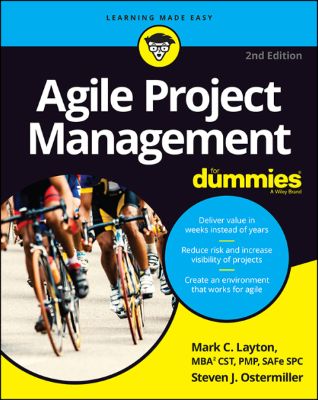
Lýsing:
Flex your project management muscle Agile project management is a fast and flexible approach to managing all projects, not just software development. By learning the principles and techniques in this book, you'll be able to create a product roadmap, schedule projects, and prepare for product launches with the ease of Agile software developers. You'll discover how to manage scope, time, and cost, as well as team dynamics, quality, and risk of every project.
As mobile and web technologies continue to evolve rapidly, there is added pressure to develop and implement software projects in weeks instead of months—and Agile Project Management For Dummies can help you do just that. Providing a simple, step-by-step guide to Agile project management approaches, tools, and techniques, it shows product and project managers how to complete and implement projects more quickly than ever.
Annað
- Höfundar: Mark C. Layton, Steven J. Ostermiller
- Útgáfa:2
- Útgáfudagur: 21-08-2017
- Hægt að prenta út 10 bls.
- Hægt að afrita 2 bls.
- Format:ePub
- ISBN 13: 9781119405733
- Print ISBN: 9781119405696
- ISBN 10: 1119405734
Efnisyfirlit
- Cover
- Introduction
- About This Book
- Foolish Assumptions
- Icons Used in This Book
- Beyond the Book
- Where to Go from Here
- Part 1: Understanding Agile
- Chapter 1: Modernizing Project Management
- Project Management Needed a Makeover
- Introducing Agile Project Management
- Chapter 2: Applying the Agile Manifesto and Principles
- Understanding the Agile Manifesto
- Outlining the Four Values of the Agile Manifesto
- Defining the 12 Agile Principles
- Adding the Platinum Principles
- Changes as a Result of Agile Values
- The Agile Litmus Test
- Chapter 3: Why Being Agile Works Better
- Evaluating Agile Benefits
- How Agile Approaches Beat Historical Approaches
- Why People Like Being Agile
- Chapter 1: Modernizing Project Management
- Chapter 4: Agile Approaches
- Diving under the Umbrella of Agile Approaches
- Reviewing the Big Three: Lean, Scrum, and Extreme Programming
- Putting It All Together
- Chapter 5: Agile Environments in Action
- Creating the Physical Environment
- Low-Tech Communicating
- High-Tech Communicating
- Choosing Tools
- Chapter 6: Agile Behaviors in Action
- Establishing Agile Roles
- Establishing New Values
- Changing Team Philosophy
- Chapter 7: Defining the Product Vision and Product Roadmap
- Agile Planning
- Defining the Product Vision
- Creating a Product Roadmap
- Completing the Product Backlog
- Chapter 8: Planning Releases and Sprints
- Refining Requirements and Estimates
- Release Planning
- Sprint Planning
- Chapter 9: Working throughout the Day
- Planning Your Day: The Daily Scrum
- Tracking Progress
- Agile Roles in the Sprint
- Creating Shippable Functionality
- The End of the Day
- Chapter 10: Showcasing Work, Inspecting, and Adapting
- The Sprint Review
- The Sprint Retrospective
- Chapter 11: Preparing for Release
- Preparing the Product for Deployment: The Release Sprint
- Preparing for Operational Support
- Preparing the Organization for Product Deployment
- Preparing the Marketplace for Product Deployment
- Chapter 12: Managing Scope and Procurement
- What’s Different about Agile Scope Management?
- Managing Agile Scope
- What’s Different about Agile Procurement?
- Managing Agile Procurement
- Chapter 13: Managing Time and Cost
- What’s Different about Agile Time Management?
- Managing Agile Schedules
- What’s Different about Agile Cost Management?
- Managing Agile Budgets
- Chapter 14: Managing Team Dynamics and Communication
- What’s Different about Agile Team Dynamics?
- Managing Agile Team Dynamics
- What’s Different about Agile Communication?
- Managing Agile Communication
- Chapter 15: Managing Quality and Risk
- What’s Different about Agile Quality?
- Managing Agile Quality
- What’s Different about Agile Risk Management?
- Managing Agile Risk
- Chapter 16: Building a Foundation
- Organizational and Individual Commitment
- Choosing the Right Pilot Team Members
- Creating an Environment That Enables Agility
- Support Agility Initially and Over Time
- Chapter 17: Scaling across Agile Teams
- Multi-Team Agile Projects
- Making Work Digestible through Vertical Slicing
- Aligning through Roles with Scrum at Scale
- Multi-Team Coordination with LeSS
- Reducing Dependencies with Nexus
- Joint Program Planning with SAFe
- Modular Structures with Enterprise Scrum
- Chapter 18: Being a Change Agent
- Becoming Agile Requires Change
- Why Change Doesn’t Happen on Its Own
- Strategic Approaches to Implementing and Managing Change
- Platinum Edge’s Change Roadmap
- Avoiding Pitfalls
- Signs Your Changes Are Slipping
- Chapter 19: Ten Key Benefits of Agile Project Management
- Better Product Quality
- Higher Customer Satisfaction
- Reduced Risk
- Increased Collaboration and Ownership
- More Relevant Metrics
- Improved Performance Visibility
- Increased Project Control
- Improved Project Predictability
- Customized Team Structures
- Higher Team Morale
- Chapter 20: Ten Key Factors for Project Success
- Dedicated Team Members
- Collocation
- Automated Testing
- Enforced Definition of Done
- Clear Product Vision and Roadmap
- Product Owner Empowerment
- Developer Versatility
- Scrum Master Clout
- Management Support for Learning
- Transition Support
- Chapter 21: Ten Metrics for Agile Organizations
- Return on Investment
- Satisfaction Surveys
- Defects in Production
- Sprint Goal Success Rates
- Time to Market
- Lead and Cycle Times
- Cost of Change
- Team Member Turnover
- Skill Versatility
- Manager-to-Creator Ratio
- Chapter 22: Ten Valuable Resources for Agile Professionals
- Agile Project Management For Dummies Online Cheat Sheet
- Scrum For Dummies
- The Scrum Alliance
- The Agile Alliance
- The Project Management Institute Agile Community
- International Consortium for Agile (ICAgile)
- InfoQ
- Lean Enterprise Institute
- Extreme Programming
- Platinum Edge
UM RAFBÆKUR Á HEIMKAUP.IS
Bókahillan þín er þitt svæði og þar eru bækurnar þínar geymdar. Þú kemst í bókahilluna þína hvar og hvenær sem er í tölvu eða snjalltæki. Einfalt og þægilegt!Rafbók til eignar
Rafbók til eignar þarf að hlaða niður á þau tæki sem þú vilt nota innan eins árs frá því bókin er keypt.
Þú kemst í bækurnar hvar sem er
Þú getur nálgast allar raf(skóla)bækurnar þínar á einu augabragði, hvar og hvenær sem er í bókahillunni þinni. Engin taska, enginn kyndill og ekkert vesen (hvað þá yfirvigt).
Auðvelt að fletta og leita
Þú getur flakkað milli síðna og kafla eins og þér hentar best og farið beint í ákveðna kafla úr efnisyfirlitinu. Í leitinni finnur þú orð, kafla eða síður í einum smelli.
Glósur og yfirstrikanir
Þú getur auðkennt textabrot með mismunandi litum og skrifað glósur að vild í rafbókina. Þú getur jafnvel séð glósur og yfirstrikanir hjá bekkjarsystkinum og kennara ef þeir leyfa það. Allt á einum stað.
Hvað viltu sjá? / Þú ræður hvernig síðan lítur út
Þú lagar síðuna að þínum þörfum. Stækkaðu eða minnkaðu myndir og texta með multi-level zoom til að sjá síðuna eins og þér hentar best í þínu námi.
Fleiri góðir kostir
- Þú getur prentað síður úr bókinni (innan þeirra marka sem útgefandinn setur)
- Möguleiki á tengingu við annað stafrænt og gagnvirkt efni, svo sem myndbönd eða spurningar úr efninu
- Auðvelt að afrita og líma efni/texta fyrir t.d. heimaverkefni eða ritgerðir
- Styður tækni sem hjálpar nemendum með sjón- eða heyrnarskerðingu
- Gerð : 208
- Höfundur : 10695
- Útgáfuár : 2017
- Leyfi : 380


